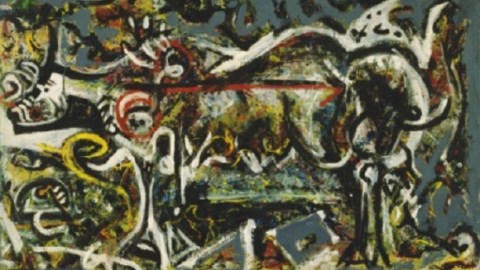Heavy Artillery: Ab Ex-travaganza at the MoMA

When the Cold War ran red hot, the United States government reached for any weapon available against the “Red Menace.” It’s hard to believe today, when federal funding for the arts is so tight, but in the 1950s the powers that be used art to fight the ideological war against Communism. Looking for a way to prove that America truly stood for freedom, the American government hauled out the heavy artillery of Abstract Expressionism, the art movement that made New York City the epicenter of the global art scene. Abstract Expressionist New York, currently at the MoMA, taps into the power of that freedom to remind us of a time when art seriously mattered.
New Yorker art critic Robert Coates first used the term “Abstract Expressionism” in 1946 to describe the art of Hans Hofmann, a teacher and father figure to other artists who would fall under Coates’ new category. The MoMA bought into the movement and its leading artists thanks to the vision of then-director Alfred H. Barr, Jr. Barr believed early on that Jackson Pollock, Barnett Newman, Willem de Kooning, Mark Rothko, and others belonged in a museum—his museum. More than a half century later, the MoMA shows off their prescience in this exhibition.
It’s staggering to think that everything in this exhibition comes from the MoMA’s collection. Even works as early in the history of Ab Ex as Pollock’s The She-Wolf from 1943 (shown above) grace their walls on a regular basis. Abstract Expressionist New York takes over nearly the entire museum across 25,000 square feet of gallery space. The fourth-floor painting and sculpture galleries contain 100 Abstract Expressionist paintings as well as 60 sculptures, drawings, prints, and photographs documenting the lives of the artists and the world they ruled.
Galleries on the second and third floors supplement the main attraction. Ideas Not Theories: Artists and The Club, 1942-1962 concentrates on the very real collaboration and interaction that went on, beyond just partners such as Pollock and Lee Krasner to even “rivals” such as Pollock and de Kooning. Rock Paper Scissorson the second floor playfully proves that Ab Ex spread beyond drip paintings to sculpture, printmaking, etchings, watercolors, lithography, and drawing. This segment of the overall show really demonstrates the MoMA has opened the vaults of their massive collection. This may be the only opportunity in our lifetime to see Abstract Expressionism in every form, just like the artists did back in the heyday of the movement.
We’ve grown so accustomed to accepting Abstract Expressionism as the quintessential art movement of New York, of America, of Modern Art since the 1950s. Everything that came afterwards—Pop, Minimalism, Performance—is a reaction to them in some way. Abstract Expressionist New York calls us to react, too. The force of this all out assault will knock you off your feet. When you regain your balance, you’ll know what it means to have art really matter—to have art fight for freedom not just against the art establishment, but against repression on a global scale.
[Image: Jackson Pollock (American, 1912-1956). The She-Wolf. 1943. Oil, gouache, and plaster on canvas. 41 7/8 x 67″ (106.4 x 170.2 cm). Purchase. © 2010 The Pollock-Krasner Foundation/Artists Rights Society (ARS), New York.]
[Many thanks to the MoMA for providing me with the image above and other materials for Abstract Expressionist New York, which runs through April 25, 2011.]





